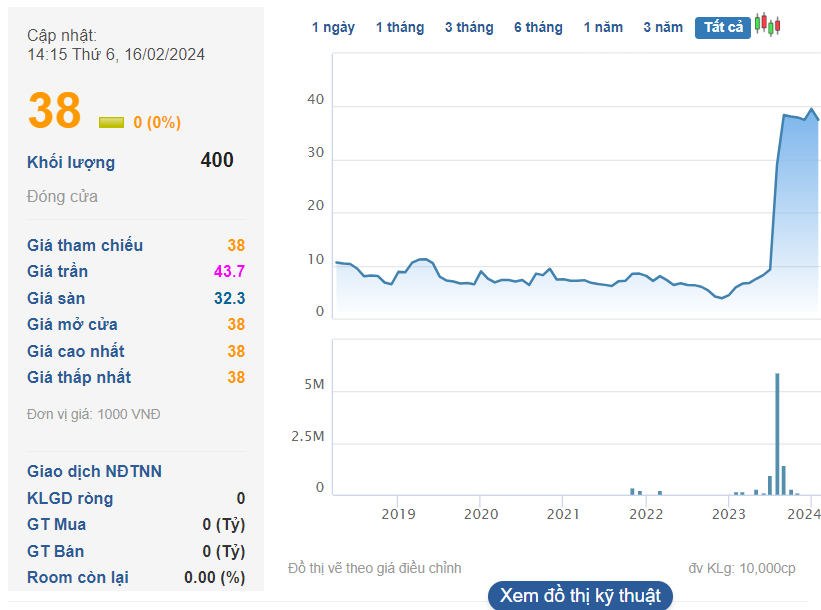In 2018, Southern Food Corporation (Vinafood 2) for the first time conducted an initial public offering (IPO) and listed on the UpCOM exchange. Two interested units, T&T Group Joint Stock Company owned by Mr. Hien and FPT Corporation Joint Stock Company, registered as strategic investors, but only T&T met the conditions.
Accordingly, Mr. Hien paid over VND 1,200 billion to purchase 125 million VSF shares of Vinafood 2 (equivalent to VND 10,100 per share), owning 25% of Vinafood 2 on the charter capital of VND 5,000 billion. This ratio remains unchanged to date.
In 2023, with the sharp increase in the price of Vietnamese rice, VSF shares also witnessed a dramatic rise from below par value. Although the price of VSF shares has cooled down from the beginning of January 2024, they are still traded around VND 38,000 per share, establishing a market capitalization of VND 19,000 billion.
Thus, Mr. Hien’s investment of VND 4,750 billion in VSF has increased four times compared to the purchase price.

However, the recently notable point of Vinafood 2 is the “clearance” of certain receivables and payables in the 2023 consolidated financial statements, resulting in a decrease in total assets by nearly VND 2,300 billion compared to the beginning of the year (equivalent to a 34% decrease). At the same time, the business results are much better than the previous period, with after-tax profit doubling in 2022.
Specifically, at the end of 2022, Vinafood 2 had outstanding receivables from a company in Bangladesh amounting to VND 1,332 billion, and payables to a company in Singapore of equivalent value. In 2023, both receivables and payables were eliminated from the balance sheet.
Vinafood 2 also has receivables of VND 625 billion from Cuba. During the period of 1993 – 1996, when Vinafood 2 was still a state-owned enterprise, the company acted as an intermediary for Vietnam’s rice aid to Cuba worth USD 25.6 million, equivalent to VND 608 billion by the end of 2022. According to the books, this is the amount that Vinafood 2 has to collect from Cuba, but at the same time, it is also the amount that the company has to pay to the Vietnamese Government at the same time.
In the first published consolidated financial statements in 2023, Vinafood 2 also “cleared” the accounts with Cuba from the balance sheet, but later adjusted and kept unchanged.
In fact, this debt does not affect the financial position of Vinafood 2 because the company is only an intermediary for payment between the two parties. Normally, if a receivable is overdue for too long, if not collected, the enterprise must establish provisions for bad debts, recorded as management expenses. With this receivable, Vinafood 2 does not have to make provisions, therefore it does not affect the company’s business results.
2023 was a successful business year for Vinafood 2 with net revenue of over VND 23,000 billion – an increase of 33% compared to the previous year, and after-tax profit of nearly VND 63 billion – tripled. Net profit reached VND 23 billion compared to a loss of VND 9 billion in the previous year.
However, as of the end of 2023, Vinafood 2 still had accumulated losses of VND 2,778 billion. This is the result after a long period of losses, since the company was transformed into a joint stock company in 2018. Vinafood 2 only made a profit in the past two years (2022 – 2023) with a very thin profit compared to the charter capital of VND 5,000 billion or the company’s nearly billion-dollar revenue.
The biggest loss of the company was in 2018 (nearly VND 1,500 billion), as a result of financial processing for previous losses, helping the company transform into a joint stock company and register for trading on the UPCoM exchange.
Since the transformation into a joint stock company in 2018, although achieving annual revenue of over VND 16,000 billion, Vinafood 2 has continuously incurred heavy losses or achieved thin profits due to the low profit margin, which is the characteristic of the rice export industry.
Vinafood 2 used to be the largest rice producer in the country with 22 subsidiary and affiliate companies and enjoyed many government incentives.
Throughout more than 40 years of operation, the “rice king” in the South was a large rice business with an annual average processing and export volume of about 2.8-3 million tons of rice, with an annual export turnover of over USD 1 billion.
However, since the transformation into a joint stock company in 2018, Vinafood 2 has faced many scandals due to misconduct in the management of the former leadership. Not only that, the core business issues also encountered many difficulties, causing this enterprise to continuously incur losses of hundreds to thousands of billion dong during the period of 2018-2021.





































